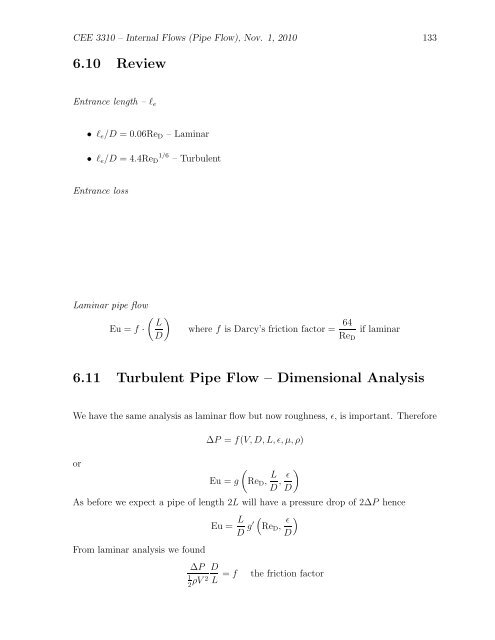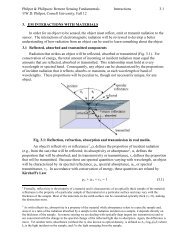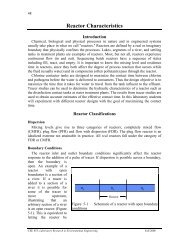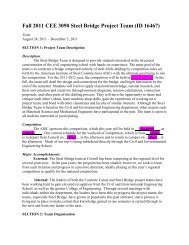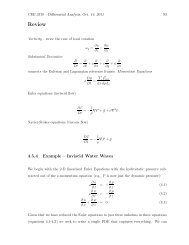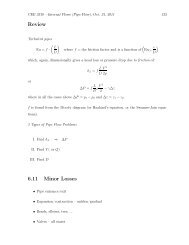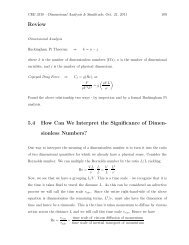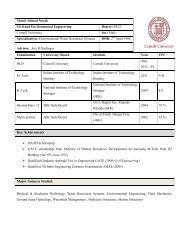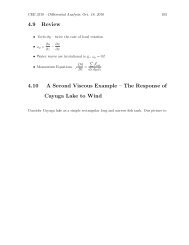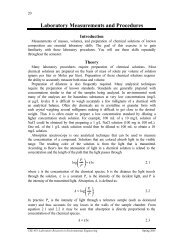6.10 Review 6.11 Turbulent Pipe Flow â Dimensional Analysis
6.10 Review 6.11 Turbulent Pipe Flow â Dimensional Analysis
6.10 Review 6.11 Turbulent Pipe Flow â Dimensional Analysis
Create successful ePaper yourself
Turn your PDF publications into a flip-book with our unique Google optimized e-Paper software.
CEE 3310 – Internal <strong>Flow</strong>s (<strong>Pipe</strong> <strong>Flow</strong>), Nov. 1, 2010 133<strong>6.10</strong> <strong>Review</strong>Entrance length – l e• l e /D = 0.06Re D – Laminar• l e /D = 4.4Re D 1/6 – <strong>Turbulent</strong>Entrance lossLaminar pipe flow( LEu = f ·D)where f is Darcy’s friction factor = 64Re Dif laminar<strong>6.11</strong> <strong>Turbulent</strong> <strong>Pipe</strong> <strong>Flow</strong> – <strong>Dimensional</strong> <strong>Analysis</strong>We have the same analysis as laminar flow but now roughness, ǫ, is important. Therefore∆P = f(V, D, L, ǫ, µ, ρ)or(Eu = g Re D , L D , ǫ )DAs before we expect a pipe of length 2L will have a pressure drop of 2∆P henceEu = L (D g′ Re D , ǫ )DFrom laminar analysis we found∆P D1ρV 2 2 L = fthe friction factor
134hence we write∆P = f L ρV 2D 2For laminar flow we found f = 64/Re – independent of ǫ.For turbulent flow f must be determined from experiments. Luckily these experimentshave been run by Nikuradse and Colebrook and to this day we rely on some form ofinterpolation of their data to estimate the friction factor for turbulent pipe flow.We haveh L = ∆Pγ + ∆zTherefore for horizontal pipe flow we can writeh L = ∆Pγ = f L V 2D 2gThis is known as the Darcy–Weisbach equation.In general we have:∆P = γ∆z + f L Dwhich accounts for the hydrostatic contribution if there are changes in inlet and outletelevation.V 22g6.12 <strong>Pipe</strong> <strong>Flow</strong> – The Moody ChartOn the next page is the Moody chart (taken from White, 1999), which is Moody’sinterpretation (and interpolation) of Colebrook’s data. We see the following• Laminar flow f independent of ǫ/D• Fully turbulent flow f independent of Re – inertially dominated• <strong>Turbulent</strong> flow at moderate Re – f a function of both Re and ǫ/D
CEE 3310 – Internal <strong>Flow</strong>s (<strong>Pipe</strong> <strong>Flow</strong>), Nov. 1, 2010 135There are curve fits to the Moody chart, the most famous of which is the Colebrookformula:⎛ ǫ ⎞1√ = −2.0 log ⎝ Df 3.7 + 2.51 √ ⎠Re D f
136which is tough to work with as it depends on √ f on both sides of the equation. Haalandhas worked out an explicit relationship that is accurate to within 2%:⎡⎛ǫ ⎞ ⎤1.111 ⎢√ = −1.8 log ⎣⎝D ⎠ + 6.9 ⎥⎦f 3.75 Re D6.13 Explicit Solutions for 3-types of <strong>Pipe</strong> <strong>Flow</strong> -Swamee & JainSwamee and Jain, (J. of Hydraulics Division,. Proc. ASCE, pp 657-664, May 1976),extended the concepts of Haaland to find explicit forms of the solutions for the threetypes of pipe flow, like Haaland, accurate to within 2% of the Moody diagram determinediterative solution. They are:{ [ ( ) ]} 0.9 −2h L = 1.07 Q2 L 1 ǫ νDloggD 5 3.7 D + 4.62 (3000 < Re < 3×10 8 ; 10 −6 < ǫ QD < 0.01)( ) [gD 5 0.5 ( ) ]h L 1 ǫ 3.17ν 2 0.5Q = −0.965 logL 3.7 D + L(Re > 2000)gD 3 h L[ ( ) LQD = 0.66 ǫ 1.25 2 4.75 ( ) ] 5.2 0.04L+ νQ 9.4 (5000 < Re < 3×10 8 ; 10 −6 < ǫ gh L gh L D < 0.01)6.14 Three Types of <strong>Pipe</strong> <strong>Flow</strong> ProblemsType Given FindI D, L, V, ρ, µ, g h L ⇒ ∆PII D, L, h L , ρ, µ, g V (or Q)III V (or Q), L, h L , ρ, µ, g DThe Moody chart is a head loss chart. It is assumed that you know all the variables listedin the given section of the Type I problem. If you do the solution is straightforward. Ifyou do not (e.g., Types II and III) iteration will be required.
CEE 3310 – Internal <strong>Flow</strong>s (<strong>Pipe</strong> <strong>Flow</strong>), Nov. 1, 2010 137Example: Type I – Moody’s Original Problem Find h L and ∆P given:with an asphalted cast iron pipe.Soln:Answers: h L = 4.5 ft, ∆P=280 lbs/ft 3
138Example: Type II – Moody’s Problem but given h L =4.5 ft, find VExample: Type III – Moody’s Problem again! Given Q = π D24 V =1.18 ft3 /s, find D


